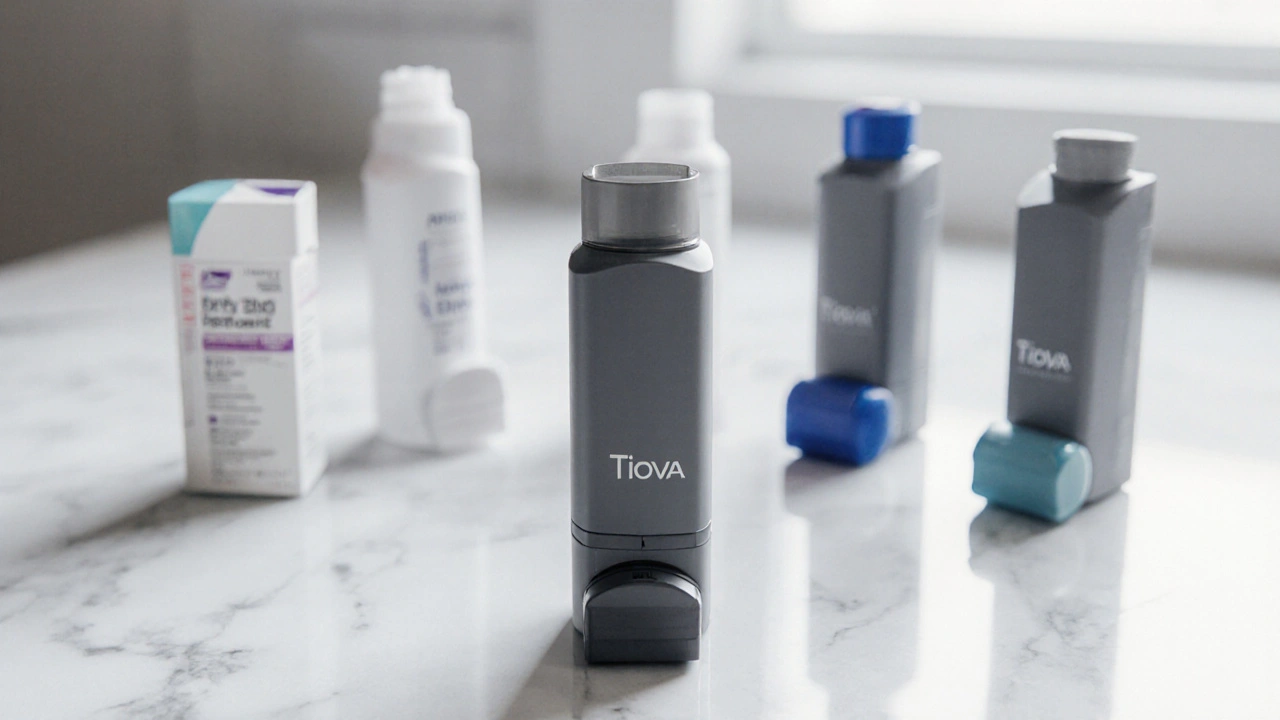COPD Inhaler Comparison Tool
Recommended Alternative:
| Inhaler | Active Ingredient(s) | Device Type | Dose Frequency | Monthly Cost (AU$) | FEV1 Improvement (%) | Common Side Effects |
|---|---|---|---|---|---|---|
| Tiova | Tiotropium 18 µg | Dry-powder inhaler (DPI) | Once daily | 45 | ≈ 12-14 | Dry mouth, throat irritation |
| Spiriva Respimat | Tiotropium 2.5 µg per actuation | Soft-mist inhaler | Once daily (2 puffs) | 55 | ≈ 12-13 | Dry mouth, cough |
| Anoro Ellipta | Umeclidinium 62.5 µg + Vilanterol 25 µg | Dry-powder inhaler | Once daily | 70 | ≈ 15-17 | Headache, nasopharyngitis |
| Stiolto Respimat | Tiotropium 2.5 µg + Olodaterol 5 µg | Soft-mist inhaler | Once daily (2 puffs) | 68 | ≈ 14-16 | Dry mouth, sinusitis |
| Breo Ellipta | Fluticasone 100 µg + Vilanterol 25 µg | Dry-powder inhaler | Once daily | 78 | ≈ 13-15 (plus anti-inflammatory benefit) | Oral thrush, hoarseness |
| Advair Diskus | Fluticasone 100 µg + Salmeterol 50 µg | Dry-powder inhaler | Twice daily | 85 | ≈ 13-16 | Oral thrush, tremor |
| Atrovent HFA | Ipratropium bromide 20 µg per puff | Metered-dose inhaler (MDI) | Every 4-6 h as needed | 30 (as needed) | ≈ 5-7 (short-acting) | Dry mouth, cough |
When it comes to long‑acting bronchodilators for COPD, Tiova Inhaler is a dry‑powder inhaler that delivers the anticholinergic drug tiotropium at a dose of 18µg once daily. Patients often wonder whether this device is the right fit or if another inhaler might give better symptom control, lower cost, or a more convenient feel. This guide breaks down the science, the numbers, and the real‑world pros and cons so you can decide without guessing.
- Tiova delivers tiotropium via a DPI, offers consistent dosing and low inhalation flow requirement.
- Spiriva Respimat uses a soft‑mist device; similar efficacy but higher cost.
- Combination inhalers (Anoro, Stiolto) add a LABA for extra bronchodilation, useful for severe COPD.
- Side‑effect profiles are comparable; dry mouth most common.
- Choose based on device preference, cost, and need for added LABA.
What makes Tiova unique?
Tiova’s dry‑powder formulation means you simply inhale through the mouthpiece; no propellant, no shaking. The device is breath‑actuated, so a minimum inspiratory flow of about 30L/min is enough - a big advantage for patients with very limited lung function. Each inhalation releases a precise 18µg of tiotropium, which blocks muscarinic receptors in the airways and keeps them open for up to 24hours.
Key attributes:
- Once‑daily dosing - improves adherence.
- Low inhalation flow requirement - works even for severe obstruction.
- Compact, disposable device - no need for battery changes.
- Minimal systemic absorption - the safety profile is favorable for older adults.
Top alternatives on the market
Below are the most commonly prescribed long‑acting bronchodilators that compete directly with Tiova. Each entry includes a brief micro‑data definition that search engines love.
Spiriva Respimat is a soft‑mist inhaler delivering the same active ingredient, tiotropium, but in a 2.5µg per actuation spray that requires twice‑daily dosing for some formulations. The mist creates larger particles that can reach deeper airways, though the device is bulkier and needs regular cartridge replacements.
Anoro Ellipta combines umeclidinium (a LAMA) with vilanterol (a LABA). Delivered via a dry‑powder inhaler, it provides dual bronchodilation once daily, ideal for patients whose symptoms are not fully controlled by a single agent.
Stiolto Respimat pairs tiotropium with olodaterol in a soft‑mist device. Like Anoro, it adds a LABA, but it keeps tiotropium as the LAMA component. The Respimat format can be easier for some users who prefer a visible spray.
Breo Ellipta contains fluticasone (an inhaled corticosteroid) and vilanterol (LABA). Although not a pure LAMA, it’s listed here because many clinicians switch patients from LAMA‑only therapy to an inhaled steroid/LABA combo when exacerbations become frequent.
Advair Diskus merges fluticasone with salmeterol (LABA) in a breath‑actuated dry‑powder device, historically used for both asthma and COPD. It’s heavier and pricier than newer combos, but still popular in certain formularies.
Atrovent HFA provides ipratropium, a short‑acting anticholinergic. While not a long‑acting alternative, it’s often used as a rescue inhaler alongside a LAMA, so it appears in many treatment plans.

Head‑to‑head comparison
| Inhaler | Active ingredient(s) | Device type | Dose frequency | Monthly cost (AU$) | FEV1 improvement % | Common side effects |
|---|---|---|---|---|---|---|
| Tiova | Tiotropium 18µg | Dry‑powder inhaler (DPI) | Once daily | 45 | ≈ 12-14 | Dry mouth, throat irritation |
| Spiriva Respimat | Tiotropium 2.5µg per actuation | Soft‑mist inhaler | Once daily (2 puffs) | 55 | ≈ 12-13 | Dry mouth, cough |
| Anoro Ellipta | Umeclidinium 62.5µg + Vilanterol 25µg | Dry‑powder inhaler | Once daily | 70 | ≈ 15-17 | Headache, nasopharyngitis |
| Stiolto Respimat | Tiotropium 2.5µg + Olodaterol 5µg | Soft‑mist inhaler | Once daily (2 puffs) | 68 | ≈ 14-16 | Dry mouth, sinusitis |
| Breo Ellipta | Fluticasone 100µg + Vilanterol 25µg | Dry‑powder inhaler | Once daily | 78 | ≈ 13-15 (plus anti‑inflammatory benefit) | Oral thrush, hoarseness |
| Advair Diskus | Fluticasone 100µg + Salmeterol 50µg | Dry‑powder inhaler | Twice daily | 85 | ≈ 13-16 | Oral thrush, tremor |
| Atrovent HFA | Ipratropium bromide 20µg per puff | Metered‑dose inhaler (MDI) | Every 4‑6h as needed | 30 (as needed) | ≈ 5-7 (short‑acting) | Dry mouth, cough |
When to stick with Tiova and when to switch
Tiova inhaler comparison often comes down to three practical questions: can you generate enough inspiratory flow? Is cost a barrier? Do you need extra bronchodilation from a LABA?
- Low inspiratory flow: If you struggle to achieve 30L/min, a soft‑mist device like Spiriva Respimat or Stiolto may feel easier because the mist doesn’t rely on high flow.
- Cost sensitivity: Tiova is generally the cheapest pure LAMA in Australia. If you’re on a tight budget and don’t need a LABA, it’s the most economical choice.
- Persistent symptoms: When FEV1 remains below 50% predicted despite Tiova, guidelines suggest adding a LABA. Anoro or Stiolto give you that combination in one inhaler.
- Side‑effect tolerance: Dry mouth is common across LAMAs. If you experience throat irritation, switching to a soft‑mist device may reduce that sensation.
Practical tips for getting the most out of any inhaler
Even the best drug won’t work if the technique is off. Here are quick checks:
- Hold the DPI upright, exhale fully away from the device, then inhale sharply and hold your breath for 10seconds.
- For soft‑mist devices, prime the inhaler as instructed (usually 2‑3 sprays) before first use.
- Keep the mouthpiece clean; a built‑up of powder can cause dosing errors.
- Mark your calendar for refill dates; many pharmacies offer automatic repeat prescriptions.
- Review technique with your pharmacist every 6months - small habit tweaks can boost drug delivery by up to 20%.

Frequently Asked Questions
Is Tiova as effective as Spiriva?
Clinical trials show that Tiova (tiotropium DPI) and Spiriva Respimat provide similar improvements in FEV1 (~12‑13%). The main differences are device feel and cost, with Tiova usually cheaper.
Do I need a LABA if I’m already on Tiova?
Only if symptoms remain uncontrolled after a few weeks of optimal Tiova use. Adding a LABA (Anoro, Stiolto) can boost bronchodilation by 2‑3% FEV1 and reduce exacerbations.
Can I switch between DPIs and soft‑mist inhalers?
Yes, but you’ll need a short retraining period. The dose is the same drug, but the aerosol particle size differs, so a physician should confirm the equivalent dose before changing.
What are the most common side effects?
Dry mouth and throat irritation appear in about 15‑20% of users across all LAMA devices. Inhaled steroids (Breo, Advair) add risk of oral thrush, while LABAs can cause mild tremor.
How often should I replace my inhaler?
DPIs like Tiova are typically discarded after 30days or 200 actuations, whichever comes first. Soft‑mist devices have replaceable cartridges that last about 60days. Always check the expiry date on the packaging.
Choosing the right inhaler isn’t a one‑size‑fits‑all decision. By weighing device mechanics, cost, and whether you need extra LABA support, you can tailor therapy to your lifestyle and lung function. Talk to your respiratory therapist or pharmacist - they can demo each device and help you stick to a plan that actually improves breathlessness.


Thank you for compiling this comprehensive comparison. The clear breakdown of device types, costs, and FEV1 improvements provides clinicians with a valuable tool for individualized therapy. It is especially helpful that the table includes both inhaler mechanics and side‑effect profiles, allowing patients to weigh practical considerations alongside efficacy. I anticipate this guide will aid many in making evidence‑based decisions.